-

新人教版高中英语必修1Unit 3 Sports and Fitness-Reading and Thinking教案
2. Sort out detailed information about Michael Jordan.(1) Understand the transitional sentence.Q: Which part is about Michael Jordan as a master? Which part is about the example he set?(2) Have the Ss Focus on why Michael Jordan is a master and what good examples Michael Jordan set when they’re reading. And think about these questions as below:Q1: How does the author describe his impressive skills?Q2: How do you understand “time seemed to stand still”?Q3: What does “graceful” mean?Q4. Which sentence do you think best describes his mental strength?Q5. Which words is important in the sentence in describing his mental strength? Why?Q6: How do you understand “unique”?Q7: What can we learn from Michael Jordan?Step 5 Discussing and recommendingRecommend their own living legends of sports.Work in groups to choose your own living legend of sports and give the reasons of your choice. Step 6 HomeworkReview the stories of Lang Ping and Michael Jordan, and try to retell them.
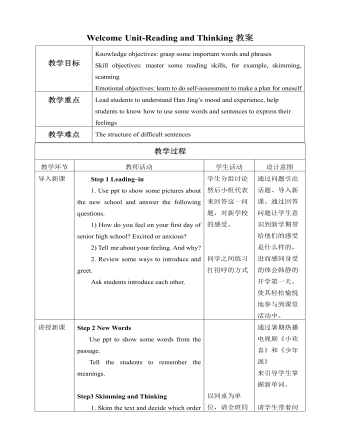
新人教版高中英语必修1Welcome Unit-Reading and Thinking教案
Step 2 New WordsUse ppt to show some words from the passage.Tell the students to remember the meanings.Step3 Skimming and Thinking1. Skim the text and decide which order Han Jing follows to talk about her first day. Time order or place order?Time order2. What is Han Jing worried about before she goes to senior high school?She is worried about whether she will make new friends and if no one talks to her, what she should do.Step 4 Fast Reading1. Match the main ideas with each paragraphParagraph 1:The worries about the new school day Paragraph 2Han Jing’s first maths classParagraph 3Han Jing’s first chemistry classParagraph 4Han Jing’s feelings about her first senior school dayStep 5 Careful Reading1. Fill in the chart with the words and phrases about Han Jing’s day. Answers: Senior high school, a little nervous; Her first maths class, classmates and teachers, friendly and helpful; Chemistry lab; new; great; annoying guy; Confident; a lot to explore2. Read the text again and discuss the questions.1) Why did Han Jing feel anxious before school?Because she was a new senior high student and she was not outgoing. What was more, she was worried about whether she can make friends.2) How was her first maths class?It was difficult but the teacher was kind and friendly. 3) What happened in the chemistry class? What would you do if this happened to you? A guy next to Han Jing tried to talk with her and she couldn’t concentrate on the experiment.
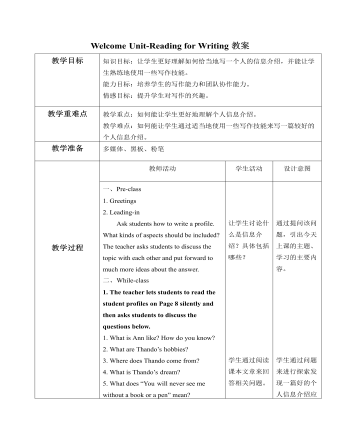
新人教版高中英语必修1Welcome Unit-Reading for Writing教案
教学目标知识目标:让学生更好理解如何恰当地写一个人的信息介绍,并能让学生熟练地使用一些写作技能。能力目标:培养学生的写作能力和团队协作能力。情感目标:提升学生对写作的兴趣。教学重难点 教学重点:如何能让学生更好地理解个人信息介绍。教学难点:如何能让学生通过适当地使用一些写作技能来写一篇较好的个人信息介绍。教学准备 多媒体、黑板、粉笔一、Pre-class1. Greetings2. Leading-inAsk students how to write a profile. What kinds of aspects should be included? The teacher asks students to discuss the topic with each other and put forward to much more ideas about the answer.二、While-class1. The teacher lets students to read the student profiles on Page 8 silently and then asks students to discuss the questions below.1. What is Ann like? How do you know?2. What are Thando’s hobbies?3. Where does Thando come from?4. What is Thando’s dream?5. What does “You will never see me without a book or a pen” mean?
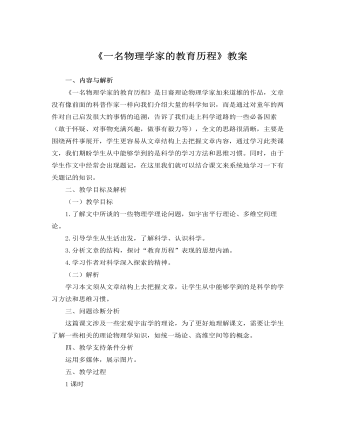
人教版高中语文必修3《一名物理学家的教育历程》教案
①阐发话题式:就是用简练的语言对所给话题材料加以概括和浓缩,并找到一个最佳切入点加以深层次阐述。吉林一考生的满分作文《漫谈“感情”“认知”》的题记是:“同是对‘修墙’‘防盗’的预见,却产生‘聪明’或‘被怀疑’的结果。‘感情’竟能如此地左右着‘认知’,心的小舟啊,在文化的河流中求索。”这个题记通过对材料的简单解释,将“感情”与“认知”二者的关系诠释得非常明白,也点明了作者的态度和议论的中心。②诠释题目式:所拟题目一般都具有深刻性特点,运用题记形式对题目进行巧妙而又全面的诠释。云南一考生的满分作文《与你同行》的题记是:“他们一路同行,一个汲着水,一个负着火,形影相随。在他们携手共进时,就产生了智慧。”这个题记形象而深刻地对“与你同行”这个题目进行了解释,言简意赅,表明了考生对感情和理智关系的认识。
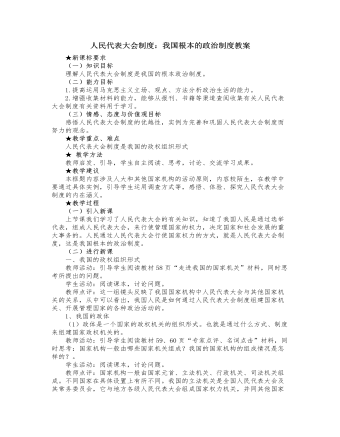
人教版高中政治必修2人民代表大会制度:我国根本的政治制度教案
二、适合我国国情的根本政治制度1、人民代表大会制度的主要内容国家的一切权力属于人民;人民在普选的基础上选举代表,组成各级人民代表大会作为国家权力机关;由国家权力机关产生其他国家机关,依法行使各自的职权;实行民主集中制的组织和活动原则等。2、为什么说人民代表大会制度是适合我国国情的根本政治制度(1)人民代表大会制度是由人民民主专政的社会主义国家性质决定的,是建立其他国家管理制度的基础,是中国社会主义民主政治最鲜明的特点。(2)人民代表大会制度以人民当家作主为宗旨,真正保证了人民群众参加国家管理,充分体现了人民的意志和利益。(3)实践证明,我国人民民主专政的国体和人民代表大会制度的政体,是中国人民奋斗的成果和历史的选择,是适合我国国情的政治制度。(4)建设社会主义民主政治,最重要的是坚持和完善人民代表大会制度,决不照搬西方的政治制度模式。

人教版高中政治必修2人民代表大会制度:我国根本的政治制度教案
(三)合作探究、精讲点拨一、我国的政权组织形式教师活动:引导学生阅读教材58页“走进我国的国家机关”材料,同时思考所提出的问题。学生活动:阅读课本,讨论问题。教师点评:这一组镜头反映了我国国家机构中人民代表大会与其他国家机关的关系,从中可以看出,我国人民是如何通过人民代表大会制度组建国家机关、开展管理国家的各种政治活动的。1、我国的政体(1)政体是一个国家的政权机关的组织形式。也就是通过什么方式、制度来组建国家政权机关的。教师活动:引导学生阅读教材59、60页“专家点评、名词点击”材料,同时思考:国家机构一般由哪些国家机关组成?我国的国家机构的组成情况是怎样的?。学生活动:阅读课本,讨论问题。教师点评:国家机构一般由国家元首、立法机关、行政机关、司法机关组成。不同国家在具体设置上有所不同。我国的立法机关是全国人民代表大会及其常务委员会,它与地方各级人民代表大会组成国家权力机关,并同其他国家机关共同组成我国的国家机构体系。

人教版高中政治必修2民主决策:作出最佳的选择教案
教师活动:总结讲评。1、对决策者:有助于决策者充分发扬民主,了解民情,反映民意,集中民智,珍惜民力。有助于决策者把人民的根本利益作为决策的出发点和立足点,增强决策的科学性,避免片面性。2、对公民:有利于促进公民对决策的理解,提高落实决策的自觉性,推动决策的实施。有利于提高公民参与公共事务的热情和信心,锻炼参与决策的能力,增强关心公共生活的政治责任感。教师活动:请同学们看教材第22页课堂探究,讨论如果你来组织这一听证会,应该邀请哪些人参加?如何设置会议程序?学生活动:阅读课本,思考讨论。教师点评:(略)(三)课堂总结、点评本节内容讲述了公民参与民主决策的方式和重要意义,通过学习,要自觉树立决策参与意识,不断提高参与决策的能力。 ★课余作业比较民主决策的不同方式
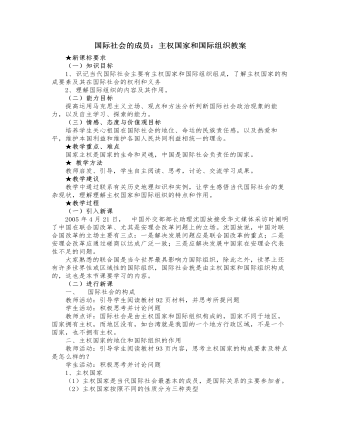
人教版高中政治必修2国际社会的成员:主权国家和国际组织教案
(1)1945.10.24日,《联合国宪章》生效,联合国正式成立。主要机构有:联合国大会、安全理事会、经济及社会理事会、托管理事会、国际法院、秘书处等。(2)联合国的宗旨:维护国际和平与安全;发展国际间以尊重人民平等权利及自决原则为基础的友好关系;促进国际合作,以解决国际间属于经济、社会、文化及人类福利性质的国际问题;作为协调各国活动的中心。简单地说,就是维护国际和平与安全,促进国际合作与发展。(3)联合国的原则:各会员国主权平等,履行宪章规定的义务,以和平方式解决国际争端,不得对其他国家进行武力威胁或使用武力,集体协作,不干涉任何国家的内政,确保非会员国遵守上述原则。(4)联合国的作用:联合国在维护世界和平与安全,促进经济、社会的发展,以及实行人道主义援助等方面发挥着积极作用。
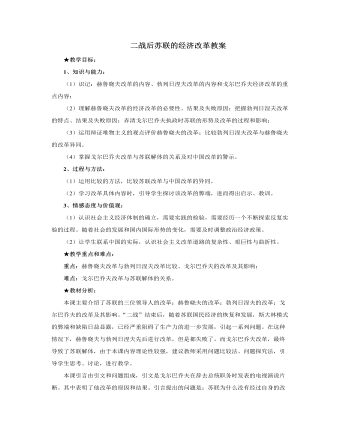
人教版高中历史必修2二战后苏联的经济改革教案
⑤强调对外关系的灵活性。戈尔巴乔夫指出在对外政策中要采取多种办法选择不同的策略路线达到既定目标。在外交谈判中不要为自己制造死胡同,也不要给对方制造死胡同,要善于迎合伙伴,寻求接触点。在这种思想指导下,苏共采取的对外战略是以军控为中心的缓和战略,具体政策是继续与美国就裁军、消减核武器、限制地区冲突等问题进行谈判,缓解苏美关系;对西欧争取建立“全欧大厦”;对东欧实行纠偏、不干涉政策;对中国改善关系,实现关系正常化;调整与第三世界国家关系,解决阿富汗、柬埔寨等问题。 3、影响:①经济改革措施仓促上马,缺少宏观决策和相应的配套措施;加上戈尔巴乔夫没有放弃苏联的传统做法,继续优先发展重工业,致使改革未达到预期的效果,苏联经济持续下滑②经济体制改革受挫后,把改革的重点转向政治领域,最终导致国内局势的失控和苏联的解体。
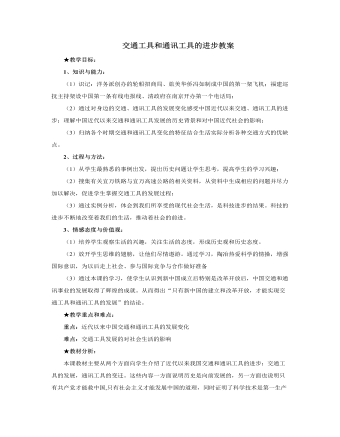
人教版高中历史必修2交通工具和通讯工具的进步教案
★教后记:历史教学的最高目标不是单纯的记忆和培养能力,而是树立正确的历史观,培养学生的历史责任感。从这一点讲,新课标及新课标教材给老师极大的发挥空间,摆脱了以往的“教教材”,真正实现了 “用教材教”,只有这样,教师才不只是一个“备课”的“教书匠”,而是一名设计教学“设计师”,以教材为砖瓦,建造有自己独特风格的教育大厦。这是我设计教学的出发点。开放式的课堂需要思想开放的教师,但对教师的课堂驾驭能力要求更高,否则“一放就活,一活就乱”,只求课堂热闹,热闹过后,学生一无所获,那么这样的开放课堂依然是失败的。开放式的课堂并不是任由学生说,教师必要的引导与客观的评价尤为重要。★问题解答⊙【学思之窗】请谈谈,火车机车的不断改进,给国民经济发展、百姓生活带来怎样的影响?答案提示:运输量大,有利于各地区的物资交流和劳动力流动,促进经济发展;交通便利快捷;机车内部环境舒适,给百姓出行带来方便。
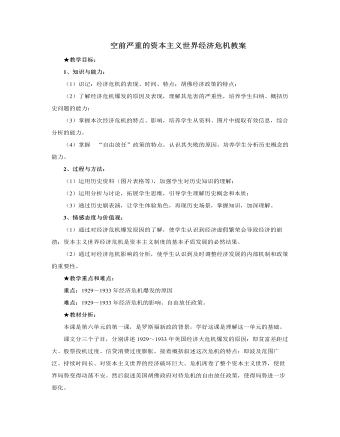
人教版高中历史必修2空前严重的资本主义世界经济危机教案
在美国历史上,很少有像胡佛那样受到老百姓讽刺、憎恶的总统。用破铁罐、纸板和粗麻布搭起来的棚户叫做“胡佛村”,手里提着的装破烂的口袋叫做“胡佛袋”,乡下的贫民把破汽车前部锯掉,套上骨瘦如柴的骡子,叫做“胡佛车” ,在公园长凳上躺着过夜的人用旧报纸裹身取暖,叫做“胡佛毯”,衣袋翻过来,一个钱也找不到,叫做“胡佛旗”,野兔被饥饿的农民抓来吃,叫做“胡佛猪”。杂耍演员插科打诨说:“什么?生意好起来了吗,你的意思是说胡佛死了吧。”★教学反思:本课内容比较条理清楚,旨在说明罗斯福新政实施的背景。备课时考虑将课文顺序进行一下调整,使学生能从较直观的危机的现象进入本课,较易激发学生的兴趣,再来分析原因学生也就比较容易接受。在分析原因时通过材料和课文的阅读,使学生自己通过思考逐步得出结论。而关于胡佛政府的措施的讲述,及问题的提出则可让学生先进行预习,为下一课进入罗斯福新政的学习做好准备。多媒体课件的应用也能使教学活动顺利流畅的进行。
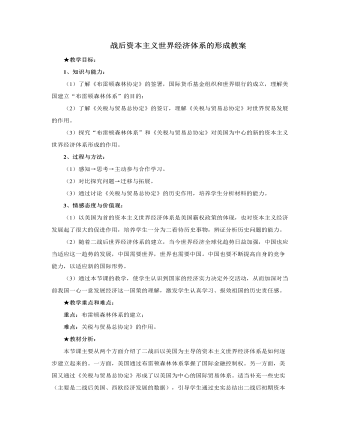
人教版高中历史必修2战后资本主义世界经济体系的形成教案
②其他货币与美元挂钩:即各会员国货币对美元的汇率按各自货币的含金量与美元确定固定比价。各国货币与美元的汇率可按各国货币含金量与美元含金量之比来确定,这称为法定汇率。例如,1946年一英镑的含金量为3.58134克,一美元的含金量为0.888671克,则英镑和美元的含金量之比1英镑=4.03美元就是法定汇率。这一规定,使美元等同于黄金,美元从此有了“美金”的说法;与美元比起来,其他国家的货币处于从属地位,确立了美元在国际货币体系中的中心地位、主导地位正如当时美国财政部长福勒所说:“各个行星围绕着太阳转,各国货币围绕着美元转。”小结: “布雷顿森林体系”是一个以美元为中心的世界货币体系,美国通过布雷顿森林体系,掌握了资本主义世界的经济命脉。(2)影响:①为世界货币关系提供了统一的标准和基础,有利于维持战后世界货币体系的正常运转,为世界经济的恢复和发展创造了条件。
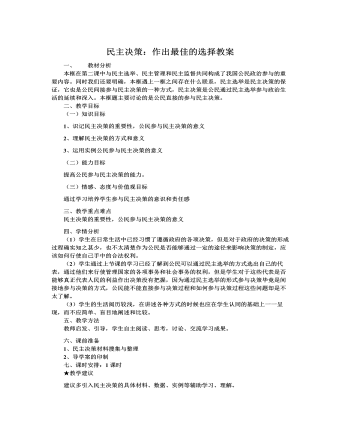
人教版高中政治必修2民主决策:作出最佳的选择教案
为了进一步增强立法的透明度,提高立法质量,国务院法制办公室将《职工带薪年休假规定(草案)》通过网络征求意见。从政治生活角度分析《职工带薪年休假规定(草案)》向社会征求意见的原因。三、反思总结四、当堂检测1.2008年6月,山西省出台了关于2008年规范教育收费、继续治理教育乱收费工作的实施意见,提出有效的规范治理对策并部署下半年治理教育乱收费工作。如果你想向当地政府反映有关教育乱收费问题,你认为可以采用何种方式和途径①社情民意反映制度②专家咨询制度③社会听证制度④电子邮件、电话、信函A、①③④ B、①②④ C、①④ D、②③2.通过上述方式参与民主决策,有助于决策者A、推动决策的实施,提高落实决策的自觉性B、对决策的理解,锻炼参与决策的能力C、克服官僚主义和不正之风,消除腐败现象D、充分发扬民主,深入了解民情,增强决策的科学性到2007年9月,山东省义务教育阶段学校实行“一费制”收费办法三周年。据此回答3—4题。
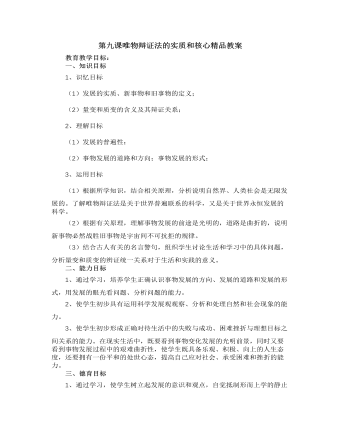
人教版高中政治必修4第九课唯物辩证法的实质和核心精品教案
a矛盾的同一性是矛盾双方相互吸引、相互联结的属性和趋势。它有两方面的含义:一是矛盾双方相互依赖,一方的存在以另一方的存在为前提,双方共处于一个统一体中;同一事物都有对立面和统一面两个方面,一方的存在以另一方为条件,彼此谁都离不开谁(形影想随、一个巴掌拍不响、不是冤家不聚头)。【举例】P67漫画:他敢剪吗?悬挂在山崖上的两个人构成一种动态的平衡。【举例】磁铁(S极和N极);没有上就没有下、没有香就没有臭、没有福就无所谓祸;【举例】父子关系(父亲之所以是父亲,因为有儿子,儿子之所以是儿子,因为有父亲);师生关系;二是矛盾双方相互贯通,即相互渗透、相互包含,在一定条件下可以相互转化。 【相关衔接】P68生物变性现象,雌雄转化现象【举例】生产与消费具有直接统一性
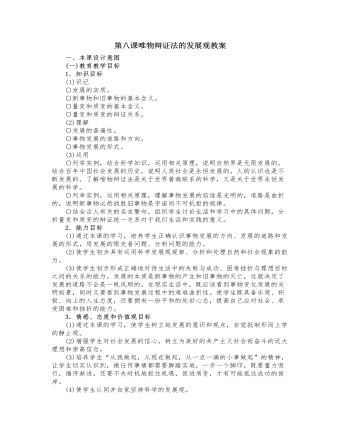
人教版高中政治必修4第八课唯物辩证法的发展观教案
1973年4月的一天,一名男子站在纽约的街头,掏出一个约有两块砖头大的无线电话,并开始通话。这个人就是手机的发明者马丁,当时他是摩托罗拉公司的工程技术人员。这是当时世界上第一部移动电话。1985年,第一台现代意义上的可以商用的移动电话诞生。它是将电源和天线放置在一个盒子里,重量达3公斤。与现代形状接近的手机诞生于1987年,其重量大约750克,与今天仅重60克的手机相比,像一块大砖头。此后,手机的“瘦身”越来越迅速。1991年,手机重量为250克左右。1996年秋,r出现了体积为100立方厘米、重量100克的手机。此后,又进一步小型化,轻型化,到1999年就轻到了60克以下。手机的体积越来越小,但功能却越来越多。以前的手机是用来通话的,现在的手机是用来享受的。今天,手机可以是相机、游戏机、音乐播放器、信用卡、电影院……手机带来的不仅仅是通信方式的改变,更是生活方式的变革。
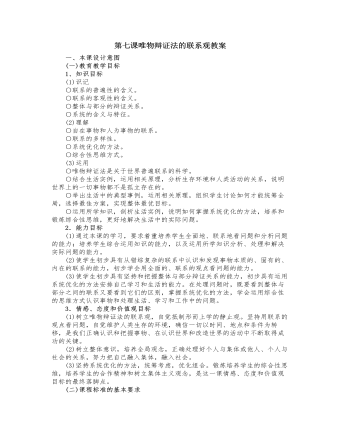
人教版高中政治必修4第七课唯物辩证法的联系观教案
2.能力目标(1)通过本课的学习,要求着重培养学生全面地、联系地看问题和分析问题的能力;培养学生综合运用知识的能力,以及运用所学知识分析、处理和解决实际问题的能力。(2)使学生初步具有从错综复杂的联系中认识和发现事物本质的、固有的、内在的联系的能力,初步学会用全面的、联系的观点看问题的能力。(3)使学生初步具有坚持和把握整体与部分辩证关系的能力,初步具有运用系统优化的方法安排自己学习和生活的能力。在处理问题时,既要看到整体与部分之间的联系又要看到它们的区别,掌握系统优化的方法,学会运用综合性的思维方式认识事物和处理生活、学习和工作中的问题。3.情感、态度和价值观目标(1)树立唯物辩证法的联系观,自觉抵制形而上学的静止观。坚持用联系的观点看问题,自觉维护人类生存的环境,确信一切以时间、地点和条件为转移,是我们正确认识和把握事物、在认识世界和改造世界的活动中不断取得成功的关键。
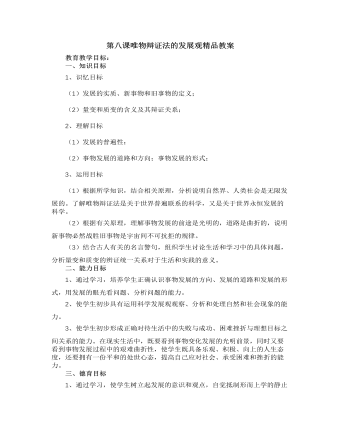
人教版高中政治必修4第八课唯物辩证法的发展观精品教案
2、理解目标(1)发展的普遍性;(2)事物发展的道路和方向;事物发展的形式;3、运用目标(1)根据所学知识,结合相关原理,分析说明自然界、人类社会是无限发展的。了解唯物辩证法是关于世界普遍联系的科学,又是关于世界永恒发展的科学。(2)根据有关原理,理解事物发展的前途是光明的,道路是曲折的,说明新事物必然战胜旧事物是宇宙间不可抗拒的规律。(3)结合古人有关的名言警句,组织学生讨论生活和学习中的具体问题,分析量变和质变的辨证统一关系对于生活和实践的意义。二、能力目标1、通过学习,培养学生正确认识事物发展的方向、发展的道路和发展的形式,用发展的眼光看问题、分析问题的能力。2、使学生初步具有运用科学发展观观察、分析和处理自然和社会现象的能力。3、使学生初步形成正确对待生活中的失败与成功、困难挫折与理想目标之间关系的能力。
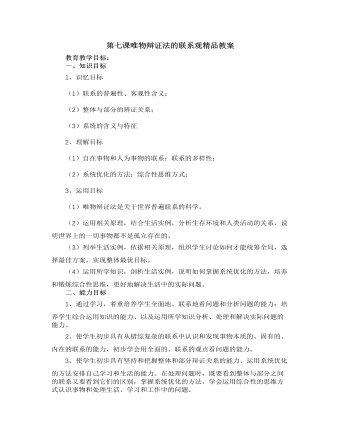
人教版高中政治必修4第七课唯物辩证法的联系观精品教案
二、分析题20世纪9 0年代以来,世界各国把发展循环经济、建立循环型社会看作是实施可持续发展战略的重要途径和实现方式。传统经济是一种“资源―产品―废弃物”单向流动的线形经济。循环经济倡导的是一种与环境和谐的经济发展模式,它要求把经济活动组织成一个“资源-产品-再生资源”的反复循环流程,做到生产和消费“污染排放量最小化、废物资源化和无害化”,以最小的成本获得最大的经济效益和生态效益。分析说明循环经济所倡导的经济发展模式是如何体现联系观点的。【答案提示】(1)联系具有普遍性和客观性。循环经济是资源、产品、再生资源相互联系的有机统一整体,它体现了联系的普遍性和客观性。(2)联系具有多样性。“资源-产品-再生资源”的反复循环体现了原因和结果在一定条件下可以相互转化;体现了三者之间的内部联系、外部联系等。(3)循环经济表明人们可以根据事物的固有联系,改变事物的状态,建立新的具体联系,以实现经济效益、生态效益和社会效益的统一。
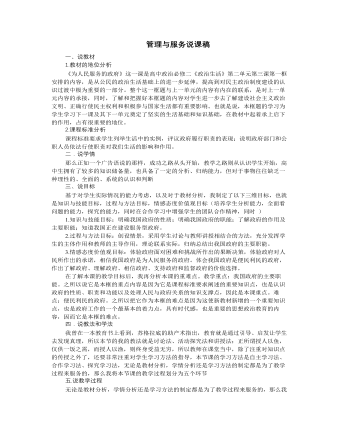
人教版高中政治必修2管理与服务说课稿
环节四 课堂小结 巩固知识本节课我采用线索性的板书,整个知识结构一目了然,为了充分发挥学生在课堂的主体地位,我将课堂小结交由学生完成,请学生根据课堂学习的内容,结合我的板书设计来进行小结,以此来帮助教师在第一时间掌握学生学习信息的反馈,同时培养学生归纳分析能力、概括能力。环节五 情景回归,情感升华我的实习指导老师告诉过我们,政治这一门学科要从生活中来到生活去,所以在课堂的最后布置了课外探究题,以此培养学生对理论的实际运用能力,同时检验他们对知识的真正掌握情况,以此达到情感的升华,本节课,我根据建构主义理论,强调学生是学习的中心,学生是知识意义的主动建构者,是信息加工的主体,要强调学生在课堂中的参与性、以及探究性,不仅让他们懂得知识,更让他们相信知识,并且将知识融入到实践当中去,最终达到知、情、意、行的统一。
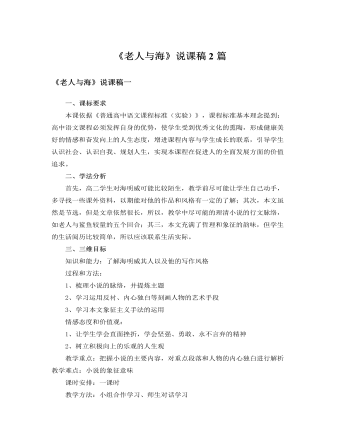
人教版高中语文必修3《老人与海》说课稿2篇
3、重要语句的理解“可是一个人并不是生来要给打败的,你尽可把它消灭掉,可就是打不败他。”解析:这是老人第一次回合之后的内心独白,也是此小说的核心精神,充分体现了老人桑地亚哥的生命理念。整句话可以分为两部分来理解,前句告诉我们,人生活在自然与社会当中,必不可少要面临一些坎坷、磨难,这些磨难、坎坷完全可以造成躯体的消灭、消亡,这是人生命的脆弱性。后句,面对挫折,只要保持一种乐观的精神,拥有一颗坚强的心灵,那么,人类执着奋斗的精神将永不磨灭。4、象征主义题目是《老人与海》,而表明上,小说是写一位老人及其在海上的经历,但实际上,老人的形象极具概括性,他已经超越了一个人的存在,而成为了人生的一种象征。老人桑地亚哥就是“硬汉子”的代表,大海则是生命旅途的象征,鲨鱼则是我们行走中的“强物”,厄运的象征。人的一生不可能一帆风顺,不经历风雨,怎能见彩虹,走在人生路途中,不可避免我们都要遇到挫折,被厄运所阻挠,只有经历与“鲨鱼”的较量,才能成为强者,唱出最美的歌。





















